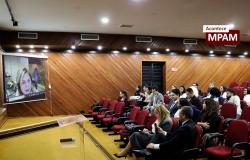TEL AVIV, Israel – Amit Soussana, an Israeli lawyer, was kidnapped from her home on October 7, beaten and dragged to the Gaza Strip by at least 10 men, some armed. According to her, after a few days of captivityhis guard started asking about his sex life.
Soussana said she was kept alone in a child’s room, chained by her left ankle. Sometimes the guard would come in, sit next to her on the bed, lift her shirt and touch her, she said.
He also repeatedly asked her when her period was due. When her period ended around October 18, she tried to talk him out of it by pretending he had been bleeding for almost a week. Around October 24, the guard, who was called Muhammad, attacked her, she said.
continues after advertising
That morning, Muhammad loosened his chain and left it in the bathroom. After she undressed and began to wash, Muhammad returned and stood in the doorway, holding a pistol.
“He came towards me and pointed the gun at my forehead,” Soussana told The New York Times. After hitting Soussana and forcing her to take off her towel, Muhammad groped her, sat her on the edge of the bathtub and hit her again. He dragged her, at gunpoint, back to the child’s room, she recalled.
continues after advertising
“Then he, with the gun pointed at me, forced me to perform a sexual act on him,” Soussana said.
Soussana, 40, is the first Israeli to speak publicly about having was sexually assaulted during captivity following the Hamas terrorist attack in southern Israel. In her interviews with the Times, she provided extensive details about the sexual violence and other violence he suffered during a 55-day ordeal.
For months, the Hamas and its supporters have denied that its members have sexually abused people in captivity or during October 7th terrorist attack. This month, a United Nations report stated there was “clear and convincing information” that some hostages had suffered sexual violence and that there were “reasonable grounds” to believe that the sexual violence had occurred during the attackalthough he acknowledged the “challenges and limitations” of examining the issue.
continues after advertising
Soussana said he decided to speak out now to raise awareness of the plight of hostages still in Gaza, a number estimated at more than 100, and with negotiations for a ceasefire stalled.
A Hamas spokesman, Basem Naim, said in a response to the Times that it was essential for the group to investigate Soussana’s allegations, but that such an investigation was impossible under the “current circumstances.”
continues after advertising
Naim cast doubt on Soussana’s account, questioning why she had not spoken publicly about the extent of her mistreatment. He said the level of detail in her account made it “difficult to believe the story unless it was planned by some security officials”.
Soussana lived alone on the west side of Kibbutz Kfar Azza. After hearing sirens warning of rocket attacks on October 7, she said she took shelter in her room, which was also a reinforced security room.
The small kibbutz was one of more than 20 Israeli villages, towns and military bases invaded that day by thousands of people crossing the Gaza border. About 1,200 people were killed that day and about 250 were kidnapped, according to Israeli authorities, triggering a war in Gaza that local health authorities say has killed at least 31,000 Palestinians.
continues after advertising
At 9:46 a.m. that day, she heard armed men outside, according to messages in her family’s WhatsApp group reviewed by the Times. Twenty minutes later, her phone died.
Moments later, “I heard an explosion, a huge explosion,” she said. “And a second after that, someone opened the closet door.”
continues after advertising
Dragged from the closet, she said she saw about 10 men rummaging through her belongings, armed with rifles, a grenade launcher and a machete.
The group dragged her through a nearby field toward Gaza. Security footage shows the group grabbing her as they struggled to restrain her. At one point, a kidnapper hung her on his back. The video shows that she struggled so hard that the man fell to the ground.
“I didn’t want to let them take me to Gaza like an object, without a fight,” Soussana said. Eventually, her captors tied her hands and feet and dragged her across the farm’s rugged land to Gaza, she said.
She was seriously injured, bleeding profusely and had a split lip, she said. The hospital report prepared shortly after her release said she returned to Israel with fractures to her right eye socket, cheek, knee and nose and severe bruising to her knee and back.
After arriving in Gaza, Soussana said, she was pushed into a waiting car and taken to the outskirts of Gaza City. A hood was placed over her head, although she could still make out her surroundings, she said.
After the hood was removed, Soussana said, she found herself in a small structure built into the roof of what she would later realize was a private home. The armed men ran down the stairs and she was left alone, facing a wall, with a man who said he was the owner of the house and his name was Mahmoud, she recalled.
She said Mahmoud was soon joined by a younger man, Muhammad. Early in her captivity, her guards chained her ankle to the window frame, she said. Around October 11, she was carried by the current to a room on the floor below. The chain was reattached to the door handle, she said.
For the next two and a half weeks in October, Soussana said, she was watched exclusively by Muhammad.
She said Muhammad slept outside the room but often came into the room in his underwear, asking about her sex life and offering to massage her.
After giving her sanitary pads, Muhammad seemed particularly interested in the time of her menstruation, she said. “Every day, he would ask, ‘Did you get your period? Did you get your period?’” recalled Soussana.
When she arrived, Soussana said, she was exhausted, scared and malnourished; Her period lasted just one day. She managed to convince him that her period had continued for almost a week, she said.
Early on the morning of the attack, she says, Muhammad insisted that she take a shower, but she refused, saying the water was cold. Undeterred, he released Soussana, took her to the kitchen and showed her a pot of water boiling on the stove, she said.
Minutes later, he took her to the bathroom and gave her heated water to bathe, she said. After washing for a few minutes, she heard his voice again at the door, she said.
“’Quick, Amit, quick,’” she remembers him saying.
“I turned around and saw him standing there,” she said. “With the gun.”
She remembers grabbing a hand towel to cover herself when he came forward and hit her.
“He said, ‘Amit, Amit, take off the towel,’” she recalled. “Finally, I took it off.”
“He sat me on the edge of the bathtub. And I closed my legs. And I resisted. He continued to punch me and pointed the gun at my face,” Soussana said. “Then he dragged me to the bedroom.”
At that moment, Muhammad forced her to perform a sexual act on him, Soussana said. After the assault, Muhammad left the room to wash, leaving Soussana sitting naked in the dark, she said.
When he returned, she remembers him showing remorse, saying, “I’m bad. I’m bad. Please don’t tell Israel.”
Soussana said her captors took her away from the border after heavy shelling. Based on the extent of the explosions and excerpts she saw on television, she later concluded that it was around the beginning of Israel’s ground invasion of Gaza on Friday, October 27.
The next day, she was rushed into a small car, she said. The driver headed towards what she would later learn was the town of Nuseirat.
The car stopped in front of what appeared to be a UN school, and Soussana said it was handed over to a man who called himself Amir. He led her up the stairs of a nearby apartment block and into another private house, she said.
The man led her to a room and closed the door behind him, she recalled. Inside, she found two young women playing cards, alongside an older man lying on a bed and an older woman sitting in a chair, she said. Soussana had been joined to four other hostages.
A few days after her arrival, she was called into the apartment’s living room, Soussana recalled. That day, guards wrapped her head in a shirt, forced her to sit on the floor, handcuffed her and began beating her with the butt of a gun, she said.
After several minutes, they used duct tape to cover her mouth and nose, bound her feet and placed the handcuffs at the base of her palms, she said. She was then suspended from a pole stretching between two sofas, causing her so much pain that she felt her hands would soon be dislocated.
They continued to beat and kick her, focusing on the soles of her feet, while demanding information they believed she was hiding from them, Soussana said.
She still doesn’t understand what exactly they wanted or why they thought she was hiding something, she said. “It was like that for about 45 minutes,” she said. “They were hitting me, laughing and kicking me, and they called the other hostages to see me,” she said.
In mid-November, the hostages were separated: The two younger women were taken to an unknown location, she said, while Soussana and the older couple were taken to a house surrounded by farmland.
They found the house full of armed men, who ordered them to sit on the floor. Suddenly, the older woman started screaming, Soussana said.
The woman was looking into a well that went down to the ground, Soussana said. “I heard one of the drivers tell him, ‘Don’t worry, don’t worry. It’s a city down there.’”
“Then it dawned on me,” Soussana said. “We are entering the tunnels.”
When they reached the bottom, the guards said they were 40 meters deep. Soussana said a large armed man with a mask was waiting for them there.
His captors spent just over an hour a day in the tunnel, climbing to higher levels at night to get fresh air, Soussana said. The hostages asked the guards to take them too.
After several days, the kidnappers brought them back to the surface and took them to another private house, Soussana said.
They were still there when Israel and Hamas agreed to a hostage deal and a temporary truce, which came into force on Friday, November 24. The next day, the three hostages were taken to an office in Gaza City.
On Thursday, November 30, the guards were preparing lunch when one of them ended a phone call and turned to Amit.
“He said, ‘Amit. Israel. You. One hour’”, recalled Soussana.
Within an hour, Soussana said, she was driven through Gaza City. The car stopped and a woman in a hijab got into it. It was another Israeli hostage: Mia Schem, who was also being released.
As they approached the Israeli border, a Red Cross worker handed Soussana a phone. A person who said he was a soldier greeted her in Hebrew.
“He said, ‘A few more minutes and we’ll meet with you,’” Soussana said. “I remember I started crying.”
Tags: Sexually assaulted tortured Gaza account woman kidnapped Hamas
--





